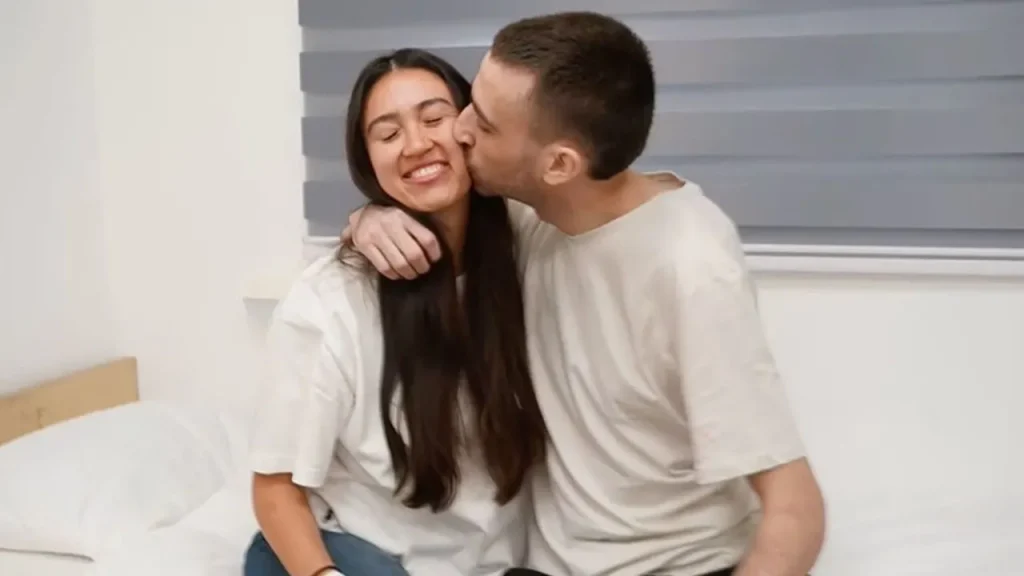Lovers Reunited: Avinatan Or and Noa Argamani’s Journey from Hamas Captivity
In a poignant moment that symbolizes hope amid tragedy, Avinatan Or and Noa Argamani—a couple who were forcibly separated when Hamas terrorists attacked the Nova music festival in Israel on October 7, 2023—were finally reunited after more than two years apart. The emotional reunion occurred Monday when Or was released from captivity, greeted by cheering supporters as he stepped out of a van, waving in acknowledgment of their support. The Israel Defense Forces (IDF) captured this touching moment in a social media post showing Or kissing Argamani on the cheek, accompanied by the simple yet powerful words: “Noa Argamani and Avinatan Or are reunited at last.” The image represents not just a personal victory for the couple, but a rare moment of joy in a conflict that has caused immeasurable suffering.
The couple’s ordeal began during what should have been a carefree day of music and celebration. Instead, the festival became the site of one of the most horrific attacks in Israel’s recent history. Argamani’s abduction was captured on video that quickly spread worldwide—a terrifying scene showing the 27-year-old Israeli student screaming as terrorists forced her onto a motorcycle bound for Gaza. The footage became one of the defining images of the October 7 attack, putting a human face to the hostage crisis that would unfold over the next two years. Meanwhile, Or was separately taken captive, beginning a lengthy period of separation during which neither knew if they would ever see each other or their families again.
Argamani’s path to freedom came first, in June 2024, when she was rescued during an IDF operation after eight months in captivity. Her release brought both joy and heartbreak; during her captivity, her mother had been battling brain cancer, desperately holding onto hope of seeing her daughter again. In a tragic turn, Argamani’s mother passed away just three weeks after her daughter’s rescue, having at least been granted her wish to see her daughter free again. Following her release, Argamani did not retreat into privacy but instead became an advocate for those still held captive. In February, she addressed the UN Security Council, delivering a powerful testimony about the conditions of her captivity. “Being here today is a miracle, but I’m here to tell you we have no time,” she told world leaders, describing the horrific conditions she endured—lack of medical care, constant fear, and the dehumanizing nature of her imprisonment.
The captives’ release came as part of a broader peace deal secured by President Donald Trump, who traveled to Egypt where he and other world leaders signed what was described as a historic Gaza peace plan. The agreement followed more than two years of brutal conflict between Hamas and Israel that began with the October 7 attacks. Upon signing the agreement, President Trump characterized the moment as “a tremendous day for the world” and “a tremendous day for the Middle East,” signaling hope that this could mark the beginning of the end to a conflict that has claimed thousands of lives on both sides. For families of hostages like Or and Argamani, the agreement represents the culmination of years of desperate hoping, praying, and advocating for the return of their loved ones.
While Or and Argamani’s reunion represents a moment of hope, it also underscores the continuing trauma faced by all hostages and their families. Mental health experts have noted that the road to recovery following such extended captivity is long and complex. Hostages often struggle with post-traumatic stress disorder, anxiety, depression, and difficulties readjusting to normal life. For couples like Or and Argamani, who experienced their trauma both together and apart, the healing process includes not only individual recovery but also rebuilding their relationship after such a profound and life-altering experience. Their story resonates far beyond their personal circumstances, serving as a powerful reminder of the human cost of conflict and the resilience of the human spirit in the face of unimaginable adversity.
As Or and Argamani begin this new chapter together, their story represents both an ending and a beginning—the end of their captivity but the beginning of their healing journey. For the Israeli public and supporters worldwide who followed their ordeal from the first viral video of Argamani’s abduction to the joyful images of their reunion, this moment provides a rare glimpse of hope amid ongoing regional tensions. Yet even as we celebrate their reunion, we must remember that conflicts like these leave deep and lasting scars on individuals, communities, and nations. The true measure of peace will be found not just in signed agreements but in the continued healing of all those affected by violence and in the commitment to building a future where such suffering does not recur. In the faces of Noa Argamani and Avinatan Or, we see both the terrible cost of conflict and the precious value of freedom, love, and human connection that sustains us through our darkest hours.


